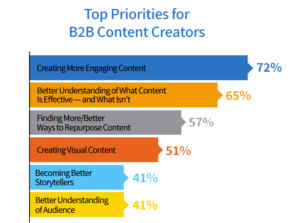Imagine someone – a perfect stranger – coming up to you while you’re walking down the street, and saying, “I know all about you. I know you have a problem with X, and I have the solution for you.” Creepy, right? Wouldn’t you do everything you could to get away from that person, as fast as possible? And yet, this is a perfect picture of the current state of content marketing. In this article I’m going to show you how to go from creep to friend.
The current state of content marketing
Below is a graph that makes it clear what the problem is. This is from a 2016 study conducted by the Content Marketing Institute. Note that the top priority is to generate more content, and the bottom priority is to understand the people who are supposed to be attracted to – and reading – that content.



And, to make things even more sad and ridiculous, “getting a better understanding of the audience” usually means looking at audience data and creating personas that will lead to definite creepy behavior. When it comes to truly understanding your customer, guessing doesn’t count – and, further, it doesn’t work. So while it may be great to show your boss that you’re generating lots of content, if that reader looks at it and thinks, “Creepy,” you’ve just wasted a whole lot of time and money, not to mention good will.
The solution: Turn the whole thing on its head.
The first priority of any content marketer is to truly get to know who they’re writing to. Not as a statistic or a generality, but real people with real subtleties (and maybe even “quirks”) and very specific desires and questions.
Why do they need or want what you’re selling? It is never, ever what you assume. Interviewing thousands of customers for my clients convinced me of that by the second interview. What roadblocks must be overcome, in their own minds, before they can reach for their wallet? Who do they have to convince? What else have they looked at, and why did they reject it (so far)? What makes them nervous about buying from you, because of their past experiences and because of the things you said – or didn’t say – on your website? What is the question they wish everyone would answer, but no one does?
All of us marketers can easily suffer from a problem that is similar to the one salespeople have. Most salespeople listen only closely enough so that they can talk. In other words, their goal is to talk, not to listen. They listen so they can talk. Similarly, marketers gather facts about their customers so they can prove to their bosses that they “get” those customers, and so they can write. They are more excited about the output than the input, just like salespeople, and just like the graph above makes clear.
Interviewing customers is only difficult because it’s so hard to get around to it; it’s the lowest thing on the long list of stuff that has to be done (again, the graph proves this). That deadline to generate more content – content that unfortunately will miss the mark – is much more compelling.
If you want very specific instructions on the best way to go about it, check out chapter 3 of my book. I’m happy to teach marketers how to interview, as I do in my book and have done in person many times – but I have found that it isn’t the method that is the problem. It’s that priority thing, but it can take as much as a year – yes, a year – for the an interviewing project to get off the ground, if it is treated as a major undertaking complete with lots of meetings (“Who should we call? Who’s going to make the calls? How many customers do we need for each product?”)
It’s much better to take a completely different approach. Go simple and consistent. Create a list somewhere – spreadsheet, CRM, project management tool, whatever – with a list of current customers. Every week at the same time, chip away at it. Send out an email to 6 customers asking for an interview (statistically, only about a third of the people you contact will answer the first time, and a second third will answer if you send out a second request with “second request” in the subject line). So 6 emails will result in 2 interviews. This will keep your interview pipeline full.
Record the conversation (tell them you’re doing it, at the start of the call), ask the open-ended questions I list in my book (plus ones that are specific to your industry) and then have the conversation transcribed by a service like Rev.com. Gather these transcriptions in a file, and once a month, summarize what you have learned and pass the information around to management and your copywriters.
One question you can ask, which will really help you go from creepy to friendly: “What kind of information would you find helpful, and how often would you like to hear from us?” Just think if all marketers asked us that question, how much more we would get out of our stuffed email boxes.





